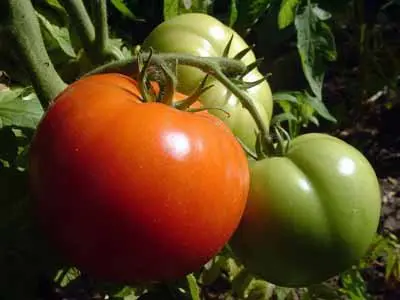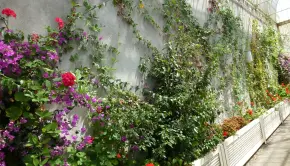Growing Tomatoes Indoors, Outdoors or in a Greenhouse
Growing Tomatoes Indoors
The most popular vegetable to grow in your garden is the tomato. The reward of a good crop far outweighs the work involved because there is nothing that tastes better than a “just picked” home grown tomato.
Growing tomatoes is not restricted to the outdoors and it is actually common to grow them indoors throughout the year. A greenhouse is ideal, but all you need is a well lighted area like a sunny, south facing window sill and if you start a new plant every couple of weeks; you can be assured of a continuous flow of ripe juicy tomatoes for your personal consumption.
If you decide to grow miniature tomatoes such as the Small Fry or Cherry variety, start with an egg container and fill it will a starter mix soil with fertilizer added. Place the seeds (more than one in each section is fine) ¼ of an inch deep in the soil and water them. Create your own greenhouse effect by covering the container with plastic and place it in a warm sunny area.
For larger varieties plant one seed in each section and transplant them into their own containers when they germinate and grow at least one inch tall. All variety of tomato seeds will germinate in 5 to 8 days. Remove the plastic when you see the shoots pop up.
To assist with indoor lighting, especially in cold cloudy months, you will need to use two or three florescent lights. Keep them on the plants at least 12 hours daily. Fertilize with a liquid all-purpose fertilizer every two weeks and water regularly.
As the plant is growing be sure to watch for insects and disease. If you notice brown or black spots, this is fungus on the leaves and they should be removed immediately so that it doesn’t spread to the rest of the plant.
When the plant grows about a foot tall, it will need to be transplanted into a one gallon container to accommodate the growing roots. At this time you should add a stake and tie the stem loosely to it. In 6 to 8 weeks, your plant should begin to show fruit. The fruit is ready to be picked when their color is rich and glossy and when they feel slightly soft. If you notice some of the tomatoes are cracked, it means that they have been over-watered.
After harvesting the fruit from your tomato plant, pull out the plant and feel free to reuse the pot and soil for your next seedling.
30 Great Tips for Growing Tomatoes
1. Make sure the plants will get at least 7 hours of full sunshine daily.
2. Tomatoes grow best in a soil that is medium rich in organic matter. This is easy to provide by adding lots of well rotted (not green) compost. Turn the compost into the top 3 or 4 inches of soil.
3. When transplanting small tomato plants, be sure to deeply bury the plant. Don’t be afraid to bury 50 to 75 percent of the plant. It’s okay to bury the lower leaves. New roots will then emerge, giving the plant a “power boost”. Never buy plants that have yellow or brown bottom leaves.
4. Within 10 minutes of transplanting young seedlings, give each plant one gallon of warm water to avoid transplant shock.
5. Be sure to space the plants the proper distance. It should say on the tomato plant, but if not, then plant 18″ to 36″ apart.
6. After the first week of transplanting, water each plant with about 16 ounces of warm water.
7. After two weeks of transplanting, place mulch around the plant about an inch thick. This keeps it cooler and helps to add much needed acidity to the soil.
8. Do not keep your soil too wet. This will kill the plant and can also cause stem disease.
9. After two weeks, the plants require only 1″ to 3″ of rain per week. As the plants mature, and as the temperatures get warmer, add more water.
10. About two weeks after transplanting, place tomato cages around the plants to help support the vines. Tomato cages are recommended to be about 48″ high.
11. Place low lying boards inbetween your rows of plants. This keeps your feet out of the mud when you are caring for your plants.
12. Never use lawn fertilizer on your tomatoes. Use a vegetable fertilizer, or one that is good for fruit. Never use the fertilizer in excess. Read the directions carefully.
13. To aid in pollination, gently shake each plant for about five seconds once the plant has sprouted flowers.
14. Watch for tomatoes to appear about 60 days after planting. Do not pick the fruit while it is green. Wait for it to ripen on the vine.
15. If your tomatoes get “splits” in them, they have received too much water.
16. Watch for pests and diseases and treat them.
17. Plastic sandwich bags can be used to protect fruit from insects, etc. while it is ripening. Just carefully cover the fruit with the bag. Be sure there is drainage and poke air holes for circulation. All plants will die without air circulation.
18. Tomatoes can also be grown in pots. Follow the same guidelines.
19. Save your tomato seeds from one year to the next and grow them again.
20. Never be in a rush to plant. Be sure there is no chance of frost occurring.
21. Try planting the tomatoes on their sides by digging a small trench. They’ll get new root shoots, and will likely provide fruit quicker.
22. Always try to keep the leaves dry when watering. Water the base of the plant only.
23. Prune shoots that grow from the stems out, otherwise they will grow and produce fruit, robbing the main plant of fruit.
24. Before planting, solarize your moistened soil with a dark covered tarp. This is best done about two weeks before you start planting.
25. Rotate your crops every three years. Be sure you are rotating with unrelated crops.
26. Never store tomatoes in your refrigerator. They lose their flavor quickly. Instead store on your kitchen counter.
27. Never try to ripen a tomato on your windowsill. This will only turn them red, but not ripe. Instead, place them in a warm, dark place and cover them with newspaper.
28. Eat them often. Tomatoes are low in calories, loaded with Vitamins A and C, and most importantly, contain lycopene. Some studies suggest that lycopene can lower your risk of cancer.
29. When a tomato plant reaches about 3 feet tall, remove all of the plants on the bottom 1 foot of the plant.
30. Try roasted tomatoes for a tasty treat. Slice tomatoes in large chunks and lightly coat with olive oil. Place the tomatoes in a single layer on a baking tray/dish that is covered with a sheet of tinfoil (aids in easy cleanup). Spice them up with salt, pepper, herbs – use whatever your favorite flavors are. You can also stick entire cloves of garlic in with the tomatoes. Roast at 425 degrees for about 40 minutes, or until the tomatoes are wrinkled and soft. Enjoy!











